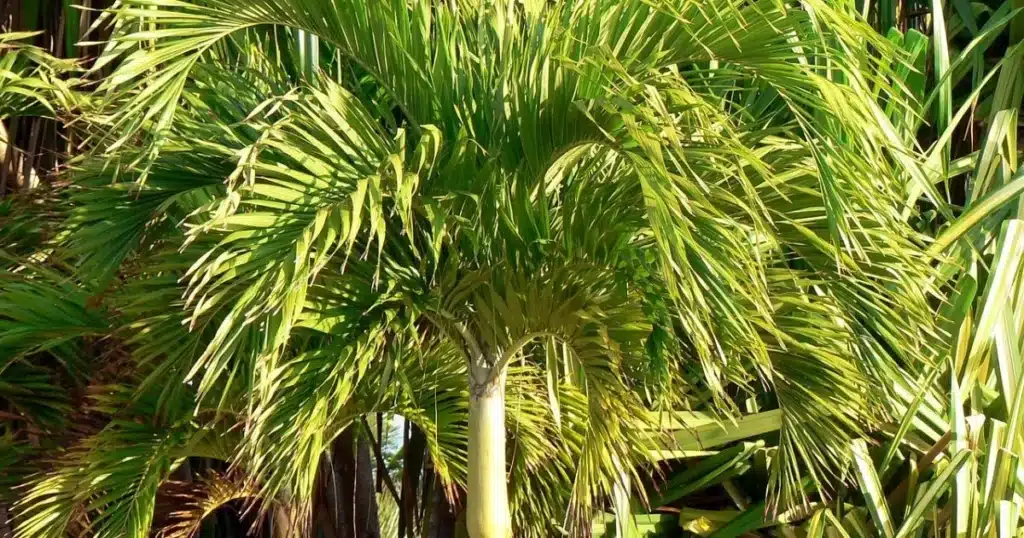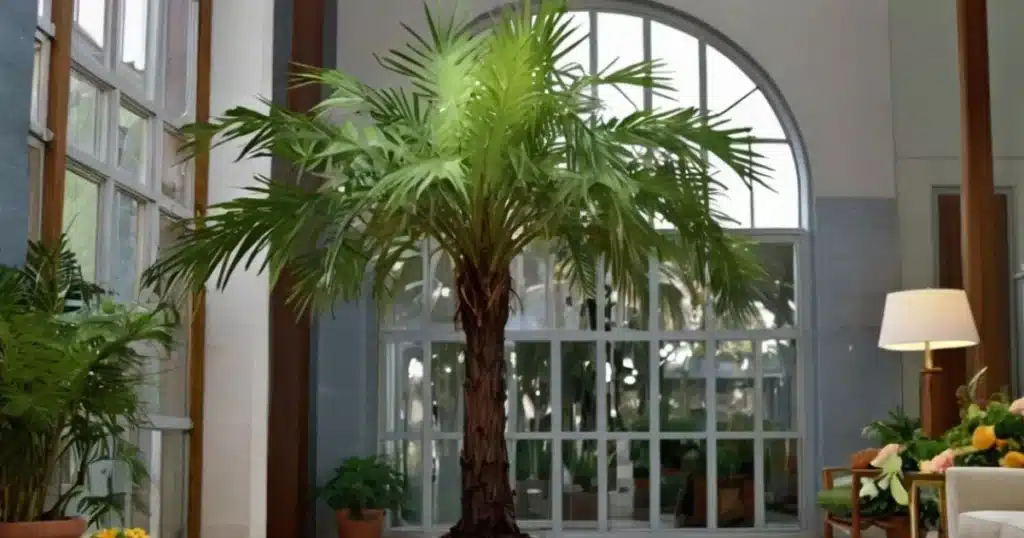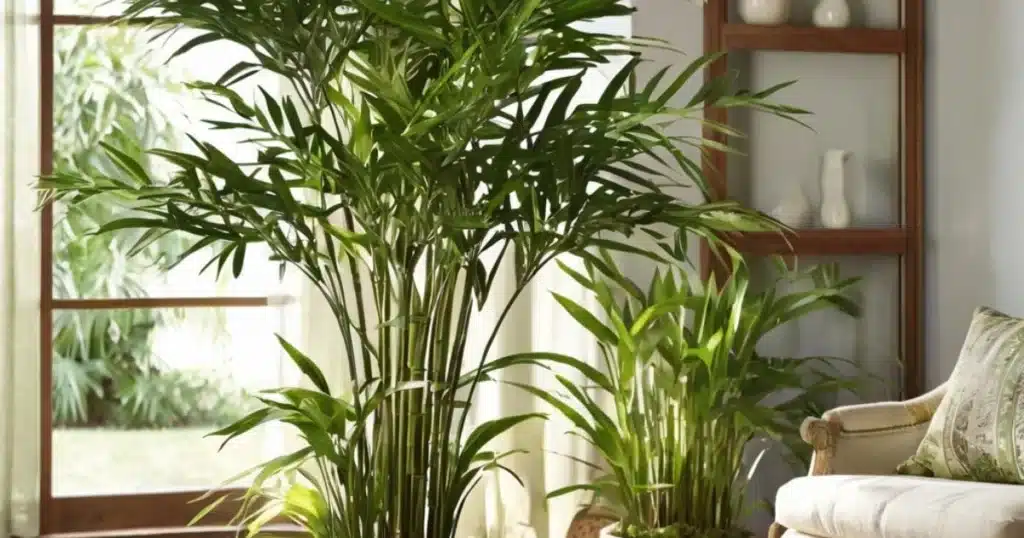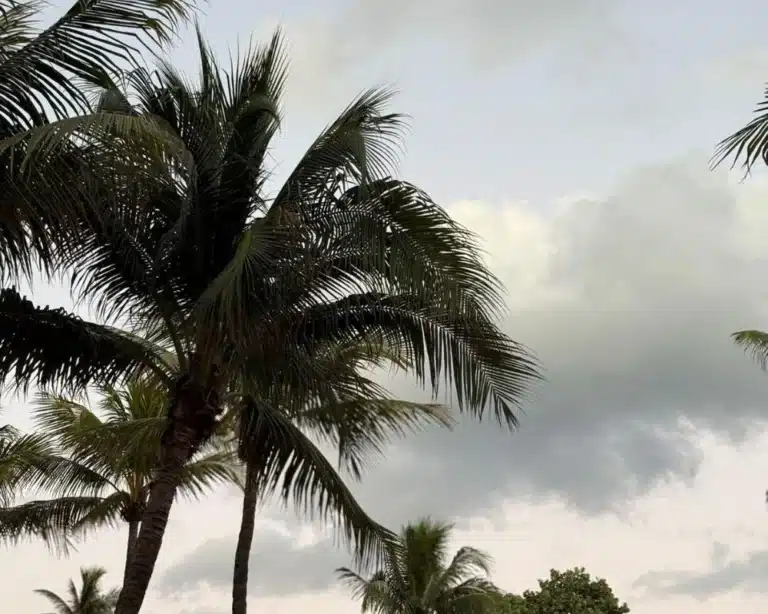Imagine stepping into your backyard and feeling as though you’ve been transported to a tropical getaway. Small palm trees can make that dream come true. These versatile and elegant trees add charm and a touch of the exotic to any space, no matter how small. Whether you’re envisioning a California-inspired patio or a cozy indoor oasis, small palm trees help turn that dream into a lush reality
Table of Contents
Understanding Small Palm Trees and Their Benefits
Small palm trees can transform any garden into a peaceful, beach-like haven. While they thrive in warm climates, some varieties also do well in cooler areas. Compact in size, small palms are perfect for small spaces, bringing beauty and life to gardens of any size.
Advantages of Growing Compact Palms
- Space-saving design: Small palms are ideal for modern gardens. They fit well without taking up too much space.
- Year-round interest: Unlike many plants, small palms look great all year. They bring a palm tree beach feel to your garden.
- Versatility: Compact palms can grow in many settings, from containers to narrow side yards. They’re easy to fit into different garden designs.
Why Choose Small Palm Trees for Your Space?
Small palms are the perfect solution for gardeners and homeowners seeking to create a vibrant, tropical aesthetic in their space without overwhelming it. Unlike towering palm varieties, these compact palms fit effortlessly into tight corners, small patios, or even indoor environments, making them incredibly versatile. Their lush fronds and exotic appeal add a unique charm to spaces ranging from cozy urban balconies to expansive gardens.
Not only do small palm trees save space, but they are also low-maintenance, thriving in a variety of climates. For example, pygmy date palms and bamboo palms are resilient options that can adapt to indoor or outdoor conditions. Their compact size and easy care requirements make them ideal for anyone, whether you’re a seasoned gardener or a beginner looking to add greenery to your home.
Additionally, small palms like the bamboo palm contribute to improved indoor air quality by naturally filtering pollutants, making them both decorative and functional. In warmer regions like Florida or California, these palms can transform your garden into a tropical retreat, while hardy varieties can even withstand light frost, offering flexibility for different environments. With their combination of beauty, adaptability, and practicality, small palm trees are a stunning addition that can elevate any space.
Popular Varieties of Small Palm Trees
Small palm trees offer diverse options to suit every gardener’s vision, combining beauty with practicality. Small palm trees can turn your garden into a lush, tropical paradise. There are many types of palm trees in Florida and beyond. Each one fits different climates and garden sizes.
| Palm Tree Variety | Appearance | Ideal Use | Key Features | Mature Height | Spread |
| Christmas Palm Tree | Slim trunk, arching fronds, red festive berries | Coastal gardens, bright indoor spaces | Tolerates full sun, adds festive charm | 6–25 feet | 5–8 feet |
| Pygmy Date Palm Tree | Petite size, feather-like leaves | Courtyards, garden corners, indoor pots | Hardy, drought-tolerant | 6–10 feet | 5–7 feet |
| Bamboo Palm Tree | Slender bamboo-like stems, lush foliage | Indoor air purification, shaded areas | Thrives in low light, easy to maintain | 4–12 feet | 3–5 feet |
| Majestic Palm Tree | Elegant upright fronds, stately silhouette | Larger indoor spaces, focal garden points | Requires moderate care, striking look | 10–12 feet | 4–6 feet |
With their range of heights and spreads, small palm trees can complement a variety of spaces, from compact indoor corners to expansive outdoor gardens, offering lush greenery and a touch of the tropics.
Many small palms serve both functional and aesthetic purposes, making them ideal ornamental trees. Learn more about other stunning ornamental trees that can elevate your garden design.
Christmas Palm tree: A Compact Beauty for Warm Climates
The Christmas Palm tree, also known as the Adonidia merrillii palm, is a stunning addition to any warm-climate garden. It offers a delightful holiday flair with its vibrant green fronds and clusters of red fruit. These appear during the winter months, making it a popular choice for festive landscaping.

Optimal Growing Conditions
The Christmas Palm tree thrives in USDA hardiness zones 10-11, where temperatures rarely dip below 40°F (4°C). It prefers full sun exposure and well-drained, sandy soil. It can tolerate a variety of soil types but performs best in nutrient-rich, slightly acidic conditions.
Seasonal Care Tips
Proper care is essential for the Christmas Palm tree to thrive. During the growing season, these palms require regular watering, especially when newly planted. Fertilize them every 6-8 weeks with a balanced, slow-release formula to encourage lush foliage and vibrant fruit production. In the winter, reduce watering and avoid pruning to allow the plant to enter its dormant phase.
Decorative Applications
The compact size and elegant silhouette of the Christmas Palm tree make it an excellent choice for containers, small gardens, and patio landscapes. These palms also work well as accent plants, lining walkways, or framing entryways.
The pygmy date palm : Compact Elegance for Small Gardens

Growth Characteristics and Care Requirements
The pygmy date palm, known as Phoenix roebelenii, grows up to 12 feet tall. It’s great for small gardens. Its delicate fronds and slender trunk add a graceful touch to any landscape.
Caring for this palm is easy. It likes well-drained soil and moderate watering. It can handle some drought too.
Decorative Uses in Landscaping
The pygmy date palm is versatile in landscaping. It can be a focal point, near entryways, or in garden beds. Its small size is perfect for container gardens, making it easy to move around.
Interestingly, it can produce small, edible palm tree fruit. This adds a unique element to your garden.
Common Problems and Solutions
- Pygmy date palm trees are mostly hardy but may face issues like leaf scorch or nutrient deficiencies. The right amount of sunlight, water, and fertilizer can solve these problems.
- Keeping an eye out for pests like mites or scale insects is crucial for their health and look.
Pygmy date palm trees are great for those wanting a tropical feel in their garden. They’re easy to care for and add beauty to any space.
Bamboo Palm: The Indoor-Outdoor Option

The bamboo palm is a top pick for those who want a palm tree for both inside and outside. Known as the reed palm or butterfly palm, it brings tropical beauty to any space. It’s a favorite among gardeners and homeowners looking to add elegance.
The bamboo palm fits well in many settings, making it a versatile choice. Its small size and bamboo-like leaves make it perfect for indoor spaces. Indoors, it can stand out as a focal point or serve as a beautiful complement to other plants. Outdoors, it brings a lush tropical touch to patios, yards, or small gardens.
The bamboo palm is easy to grow because it adapts to various conditions. It can tolerate different soils and light levels, making it suitable for beginners and experienced gardeners alike. This means it’s low-maintenance, no matter where you live or how much gardening knowledge you have.
If you’re looking for a plant that is both beautiful and practical, the bamboo palm is an excellent choice. It can make any indoor or outdoor space more attractive and welcoming.
Majestic Palm Tree: Grandeur and Elegance for Spacious Settings
The Majestic Palm tree, scientifically known as Ravenea rivularis, is a popular choice for creating a lush, tropical ambiance. With its tall stature, reaching heights of up to 40 feet in optimal outdoor conditions, it lives up to its name by adding a sense of grandeur to gardens and landscapes. Indoors, it grows more modestly, making it a striking centerpiece for large rooms or office spaces.

Optimal Growing Conditions
The Majestic Palm thrives in USDA zones 9-11, preferring bright, indirect light or partial shade. It enjoys rich, well-draining soil and a consistent watering schedule, as it is less drought-tolerant than other palm species. High humidity is ideal for this palm, especially when grown indoors, where misting or a humidifier may be needed.
Decorative Applications
This palm’s long, feathery fronds make it a stunning backdrop for garden beds or a focal point in spacious outdoor settings. Indoors, its stately appearance adds elegance to living rooms, foyers, or even open-concept office spaces. Its versatility allows it to be used in container gardening, provided the pot is large enough to accommodate its growing roots.
Care Tips and Challenges
While relatively easy to care for, the Majestic Palm requires regular attention to prevent issues like yellowing fronds, often caused by overwatering or poor drainage. Additionally, it is prone to spider mites when kept indoors; regular cleaning of the leaves can help maintain its health and beauty.
Majestic Palm trees are perfect for those seeking a plant that combines size, elegance, and a touch of the tropics, whether in expansive gardens or airy indoor spaces.
Designing Your Garden with Small Palm Trees
Small palm trees are a fantastic way to elevate the design of your garden, adding both beauty and functionality to a variety of settings. Whether you’re looking to create a tropical paradise, a minimalist retreat, or a coastal-inspired oasis, small palm trees can fit perfectly into each theme, enhancing the overall ambiance of your space.
Incorporating Small Palm Trees into Different Themes
- Tropical Theme: Small palm trees, such as the Christmas Palm Tree or the Pygmy Date Palm, are ideal for creating a tropical atmosphere in your garden. Pair these palms with vibrant plants like hibiscus and bird-of-paradise to infuse your outdoor space with colorful blooms and lush foliage. This combination evokes a vibrant, island-inspired vibe, perfect for backyard getaways or poolside patios.
- Modern Minimalist: For a sleek, contemporary look, use small palm trees as striking focal points. Opt for compact varieties like the Bamboo Palm or Majestic Palm, which can stand out in minimalist designs. Plant them in simple, elegant pots—think concrete or matte black containers—and position them strategically to create a clean and uncluttered aesthetic that brings a touch of nature into your modern space.
- Coastal Vibe: If you’re aiming for a relaxed, coastal feel, small palm trees are an essential element. Combine varieties like the Christmas Palm Tree or Lady Palm with white pebbles, blue ceramic planters, and perhaps some beach-themed decor. This pairing creates a refreshing atmosphere that brings to mind sunny beaches and gentle ocean breezes. Small palm trees thrive in sunny spots, and their tropical look is perfect for patios, decks, or balconies that get plenty of natural light.
Small palm trees are perfect for enhancing outdoor spaces like rock patios. Pair your palms with stylish patio elements—explore creative rock patio ideas for inspiration.
Enhancing Small Spaces
Small palm trees are ideal for maximizing the potential of small gardens or urban environments. With their compact size, these palms can thrive in smaller areas, adding lush greenery without overcrowding the space. One way to optimize your small garden is by using vertical gardening techniques, such as placing palms in elevated planters or wall-mounted pots. This allows you to enjoy the beauty of small palm trees while maintaining more ground space for other plants.
Additionally, placing your palm trees near seating areas or outdoor lounges is a great way to enhance both their aesthetic appeal and practicality. Palms like the Bamboo Palm or Pygmy Date Palm can provide a bit of shade and help create a relaxing atmosphere, perfect for enjoying quiet moments outdoors. By strategically placing your small palm trees, you can transform even the tiniest of spaces into an inviting, serene retreat.
Maintaining and Caring for Small Palm Trees
Small palm trees are easy to care for and can brighten up any garden. They can even thrive in places with palm trees in the snow. To keep your palms healthy and vibrant, it’s key to know how to water, fertilize, prune, and protect them in winter.
Watering and Fertilization Guidelines
Most palms prefer consistent moisture without being waterlogged: Small palms need consistent moisture but avoid overwatering. Keep the soil moist but not soggy.
Fertilization Tips :
Adjust frequency based on climate and palm type: Feed them with a balanced, slow-release palm fertilizer every few months during the growing season.
Ensure micronutrients like magnesium and iron are included.
Pruning and Maintenance Schedule
Regular pruning is crucial for your palms. It removes dead or damaged fronds, improving the plant’s look and health. Prune as often as every few months or once a year, depending on the type.
Winter Protection Methods
In cold areas with palm trees in the snow, winter can be tough. Use insulating wraps or burlap to shield the trunk and leaves. Apply mulch around the base to help insulate the roots and maintain warmth. A cold frame or greenhouse can also protect your palms during the cold months.
By following these care tips, your small palm trees will thrive, even in colder climates.
Common Diseases and Pests of Small Palms
Keeping small palm trees healthy is key. As these palms become more popular, knowing about diseases and pests is vital. Let’s look at common problems and how to manage them.
Disease Challenges
Lethal Bronzing is a major threat to small palms. It’s caused by a deadly bacteria. Catching it early and treating it fast is crucial to stop it from spreading.
Fusarium Wilt is another disease affecting palms. It causes leaves to turn yellow, wilt, and eventually die. Watching for signs and using fungicides can help fight this disease.
Pest Infestations
Small palms face many insect pests, like the Palm Leaf Skeletonizer and Palmetto Weevil. These pests harm the plant’s look and health. Regular checks and pest control are needed.
- Palm Leaf Skeletonizer: This moth larvae eats the leaves, leaving them looking like skeletons.
- Palmetto Weevil: These beetles damage the trunk and crown, which can kill the plant.
“Pest infestations can pose challenges to small palms. Discover how to identify and manage pests like the carpet beetle to keep your garden healthy.
Edible Palm Tree Fruits and Culinary Uses
**Table: Popular Palm Tree Fruits and Recipes**
| Palm Type | Fruit | Recipe |
| Pygmy Date Palm | Dates | Date syrup or energy bars |
| Christmas Palm tree | Red berries | Decorative but non-edible |
| Coconut Palm | Coconut | Smoothies, desserts |
FAQ
What are the advantages of growing small palm trees in gardens?
Small palm trees are great for gardens because they are compact and fit in tight spaces. They bring a tropical feel and add beauty to your yard. They also add interesting texture and visual appeal to your landscaping.
What are the ideal growing conditions for small palm trees?
Small palm trees need full sun, well-drained soil, and consistent moisture. They can grow well in many climates, even in cold places where they might even grow in the snow.
What are some popular small palm tree varieties for gardens?
Popular small palm trees for gardens include the pygmy date palm, bamboo palm, Christmas Palm tree, and dwarf California fan palms. Each has its own special features and benefits for your garden.
How do I care for a small palm tree in my garden?
To care for small palm trees, water them regularly, fertilize them often, prune them, and protect them from cold in winter. Keeping up with these tasks and watching out for diseases and pests will help your palm trees stay healthy and live long.
Can small palm trees be grown indoors?
Yes, some small palms like the bamboo palm do well indoors. They can make your indoor spaces feel more tropical and elegant.
Can Small Palm Trees Survive in the Snow?
Some varieties, like Pygmy Date Palms, can tolerate light frost, but they thrive in warmer climates.
What Are the Best Types of Palm Trees in Florida?
Popular options include Pygmy Date Palms, Christmas Palm trees, and Bamboo Palms.
How can I incorporate small palm trees into my garden design?
Small palm trees can be used in many ways in garden design. They can be the main attraction, add to borders, be part of container gardens, or even create a mini tropical paradise. Their flexibility makes them great for creative landscaping.


4 thoughts on “Top 4 Stunning Small Palm Trees to Elevate Your Garden”